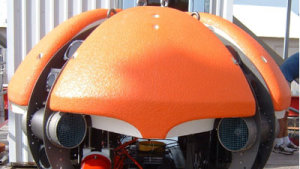The Chicago Tribune offered up a Christmas day story on ENDURANCE, the NASA robot recently sent out for a shakedown mission in Lake Bonney, Antarctica. The lake is locked down under fifteen feet of ice, a place that could prefigure what we find under the ice on Europa. ENDURANCE stands for Environmentally Non-Disturbing Under-ice Robotic ANtarctiC Explorer, a vehicle created by Texas-based Stone Aerospace that is the successor to the Deep Phreatic Thermal Explorer (DEPTHX), which explored Mexican geothermal sinkholes in early 2007.

The Lake Bonney expedition is covering its story via blog entries accessible here, the most recent being a note from December 21, dealing with navigation in an environment rich in icebergs up against the face of a glacier. You may remember from an earlier story that ENDURANCE spent several days in the water at Lake Mendota, on the University of Wisconsin’s campus, last winter, with the new work pushing it into much harsher conditions. And history buffs will recall that Endurance was the name of Sir Ernest Shackleton’s ship, a vessel the Antarctic explorer had to abandon when it became abandoned in pack ice and crushed.
The incredible trek to the Antarctic coast that followed, and the ensuing journey to South Georgia, have become the stuff of legend, a fate that may well await the robotic ENDURANCE’s successors when they tackle environments like Europa and who knows what other subterranean bodies of water in the Solar System. For now, the current ENDURANCE is performing flawlessly at the end of its fiber-optic tether, “…determining its own routes underwater, evading obstructions and returning by dead reckoning to the team of relieved scientists,” in the words of the Tribune.
Image: ENDURANCE, an underwater explorer that may presage remarkable expeditions to come. Credit: Stone Aerospace.
And this is interesting:
As it hovers under the ice, the robot spools out a series of instruments every few minutes that measure water temperature and dissolved materials as well as taking pictures of the ice above and the dark lake floor below. Days after it began, the robot found what looked like an outcrop of lichen-covered rocks—microbial colonies that researchers said were unlike any others known to exist in the lake.
“There’s some things in these images that I’ve never seen before,” said investigator Peter Doran of UIC [University of Illinois at Chicago].
Oh for the chance to try out a matured successor to ENDURANCE off-world! That, of course, will be a long-time coming, but developing the key technologies now is another step in the right direction. Lake Bonney, we now learn, turns out to be an ancient salt lake trapped under fresh water and ice, a reminder that we have much to learn about our own planet as we shake out these new tools. Autonomy is the ticket, of course, and ENDURANCE is already proving that it can choose its own routes, avoid obstacles, and work its way back to the scientists who dispatched it under some of the most extreme conditions on Earth.
Addendum: You can also track this story via Shilpa Gulati’s blog; Shilpa is a member of the ENDURANCE team now on the ice.


Hi Paul;
This underwater probe is fascinating.
When we eventually send such probes to Europa, I’d imagine that some sort of radiothermal heater or perhaps a conventional fission reactor will be necesary to provide the heat required for the probe to melt through the ice to reach the water below.
Perhaps some sort of noncontaminating high explosives could be used to cut through the ice.
I also wonder if solar energy might be a difficult energy source to utilize for such a melter simply because the intensity of solar radiation at Europa is about 1 1/2 orders of magnitude less than that on Earth. Perhaps large sheets of flexible polymeric PV material could be laid out on the ice surface. A square kilometer of PV material with 10% conversion effeciency should yield about 3 to 4 Megawatts which should provide plenty of heat for the probe to melt through the ice.
Thanks;
Jim
January 20, 2009
Jupiter and Saturn Both Targets of NASA/ESA Joint Missions
Following the selection of the Laplace proposal in October of 2007 as a candidate mission within the Cosmic Vision plan, the European Space Agency (ESA) performed an internal assessment study, with this preliminary study completed in 2008.
Full article and links to documents here:
http://www.satnews.com/cgi-bin/story.cgi?number=1876777433
Nereus Soars to the Ocean’s Deepest Trench
New hybrid deep-sea vehicle descends 6.8 miles in the Challenger Deep
It took a village of engineers to build a completely new type of unmanned deep-sea robot that can reach the deepest part of the ocean. On May 31, 2009, a team of engineers at Woods Hole Oceanographic Institution (WHOI) celebrated as the unique vehicle called Nereus dove to 10,902 meters (6.8 miles) in the western Pacific Ocean’s Mariana Trench.
“Until now, exploring below 6,500 meters (4 miles) with any vehicle was impossible or impractical,” said Andy Bowen, a WHOI engineer and project manager for Nereus. “In 2000, we began to conceive a vehicle capable of reaching those final 4,000 meters of the ocean, which are virtually unexplored.”
To build Nereus to withstand the crushing pressures at such depths—especially at the relatively inexpensive cost of $8 million—the engineering team “pushed the envelope on a lot of fronts of technology,” WHOI engineer Matt Heintz said.
“Every square inch of Nereus is designed to withstand about a thousand times the pressure that we are exposed to right here on Earth’s surface,” Bowen said. “Each square inch of Nereus is loaded with about 15,000 pounds; that’s equivalent to having three SUVs stacked on your big toe. That’s a shocking amount of energy that is trying to squeeze Nereus and cause it to implode.”
Full article, images, an video here:
http://www.whoi.edu/oceanus/viewArticle.do?id=57606§ionid=1000